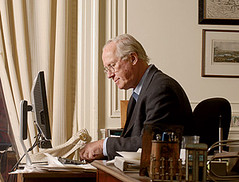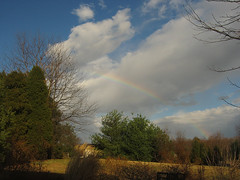This post by SGA board member Kaid Benfield originally appeared on his blog at the Natural Resources Defense Council (NRDC). We thank him for allowing us to reprint his post in full here, encourage you to read his blog daily, and join him in recognizing and thanking Richard Moe for his years of service preserving, building and advocating for American communities at the National Trust for Historic Preservation. As Kaid said to me, Smart Growth America might not exist without him. – Stephen Davis, SGA Communications Associate.
—
By Kaid Benfield, SGA Board Member and Director of NRDC’s Smart Growth program.
Richard Moe, for the last 17 years the president of the National Trust for Historic Preservation, is stepping down from that post and into retirement, as he announced late last year. His enormous impact on the Trust, on the cause of smart growth and sustainability, and on all of us who care about community, will remain.
Twenty years ago many people thought of the National Trust as a terrific, if a little stodgy, steward of historic buildings in America. That wasn’t bad. But under Dick’s leadership it became something much more: an articulate voice not just for buildings but for community; an advocate not just for preserving the past but for securing a more sustainable future that is consistent with the best of our past.
 When I first became interested in addressing the many problems associated with sprawl in the mid-1990s – before Parris Glendening gave our cause the name ‘smart growth’ – the Trust was one of the first organizations I turned to, because they were already there, in the person of my friend Constance Beaumont, then the organization’s director of state and local policy, and her boss, who turned out to be Dick Moe. I learned immensely from them and eventually, along with a few other organizations and enlightened leaders, we ended up forming the coalition that, over time, became Smart Growth America.
When I first became interested in addressing the many problems associated with sprawl in the mid-1990s – before Parris Glendening gave our cause the name ‘smart growth’ – the Trust was one of the first organizations I turned to, because they were already there, in the person of my friend Constance Beaumont, then the organization’s director of state and local policy, and her boss, who turned out to be Dick Moe. I learned immensely from them and eventually, along with a few other organizations and enlightened leaders, we ended up forming the coalition that, over time, became Smart Growth America.
That’s when I got to know Dick personally, as really only a handful of us began to shape the coalition and staff that eventually became the centerpiece of our movement. Probably long forgotten by most is that it was the Trust that took the early leadership of our efforts, hosting the meetings, taking the initial baby steps at coordination, contacting the funders. After SGA’s founding board of directors was formed and we began meeting to add shape to the efforts, Dick’s voice was generally the most respected in the room. Not that he didn’t listen and evolve with the rest of us: quite the contrary. But he had a contagious confidence in what we were doing and, frankly, was willing to be bolder than my own instincts would have had it on some important occasions. Our movement is better for it.
During this time Dick became a kind of mentor to me, though he probably doesn’t know it. I’m convinced that the best way to learn professionally is to be around people who are really good at what they do, observe what they say and do, and let their influence rub off. (Actually, that works pretty well for sports, music, and life, too.) My own longtime boss, John Adams, and Dick were both as good as it gets for professional role models.
 Early during his tenure Dick encountered the battle to save some of rural Virginia from being cheapened and trampled by a really bad idea called the Disney’s America theme park. In a fascinating interview, Dick says that’s what woke him up to the threat posed by sprawl to historic landscapes and communities. That fight was massive, diverse and complicated (I played a very small role) but, more than any other single thing, it was Dick’s galvanizing many of the country’s leading historians that saved the day, as they spoke up for preventing desecration of some of the country’s most historic Civil War sites. He became an eloquent champion of smart growth as a result.
Early during his tenure Dick encountered the battle to save some of rural Virginia from being cheapened and trampled by a really bad idea called the Disney’s America theme park. In a fascinating interview, Dick says that’s what woke him up to the threat posed by sprawl to historic landscapes and communities. That fight was massive, diverse and complicated (I played a very small role) but, more than any other single thing, it was Dick’s galvanizing many of the country’s leading historians that saved the day, as they spoke up for preventing desecration of some of the country’s most historic Civil War sites. He became an eloquent champion of smart growth as a result.
And that’s not all. He took the Congressionally chartered Trust out of the federal appropriations game so that it could be more independent, a better advocate. He presided over the maturation of the organization’s innovative Main Streets program. In the last several years, he has stressed the connection between preservation and sustainability, recognizing that in many cases preservation is a far greener choice than building anew, and that preservation with green restoration is better yet for addressing climate change. And he is one of a distressingly small group of leaders who have rightlyurged caution in the demolition of properties in our older cities in the name of ‘right-sizing’ places that have suffered disinvestment and sprawl.
A few tidbits from the interview:
‘I feel very proud of a lot of things. I think we helped to define sprawl with the Disney battle. I didn’t see sprawl as a preservation issue before that . . .
‘People come to a neighborhood like Dupont Circle in Washington or LoDo in Denver, and they say, ‘This is great, this is terrific. Look at that old building. It blends in so nicely with that new building. And there are mixed uses.’ People love this stuff.
They may not see it as preservation, but they see it as a concept they embrace. The net result is that demolition is not the first option any more . . .
‘The most vital gathering and residential places in every major American city are historic places, older places, whether it’s Capitol Hill here in Washington, or South Beach in Miami, or the West Village in New York City. They’re where people gravitate. Preservation has proved itself relevant in that way. Our focus on sustainability (extending the life of older and historic buildings by making them more energy efficient) furthers the cause of preservation and addresses one of the most challenging issues of our time—climate change. . .
‘I feel very privileged to have been here. There are people who have risen through the ranks because they just love this place and want to continue to be part of it. And I am going to be one of them.’
Well done, my man. Those of us who have had the benefit of working with you can’t possibly thank you enough, but some of us can at least honor you in a blog post. We’ve been privileged, too.
This post originally appeared here on Kaid Benfield’s blog at the NRDC Switchboard.